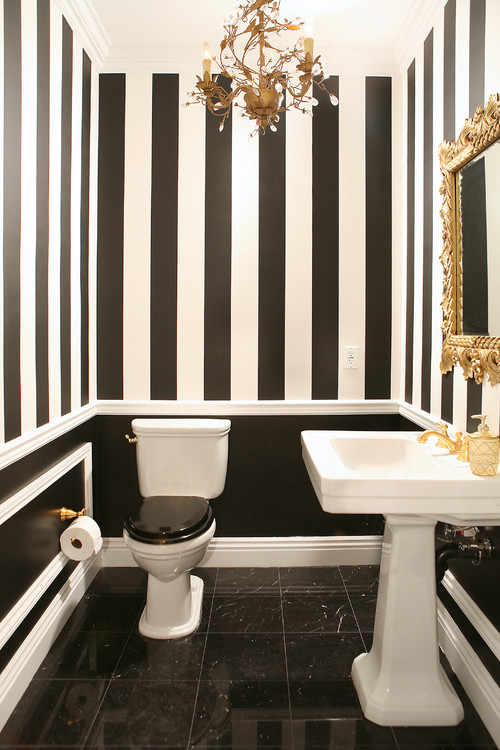5 Common Home Painting Bloopers—and How To Avoid Them

Getty Images
Plenty of us are looking to cut costs these days. The problem: Home upgrades that seem like wallet-friendly DIY projects often turn into money pits that require professional intervention. Take painting your home, for example: At face value, it seems like a great plan. Experts say painting a room yourself costs about half of what hiring a pro will set you back—that is, unless you screw it up.
Which happens. A lot.
If you’re determined to revamp your house with a new color or creative design, avoid making these common painting bloopers—lest you find yourself shelling out big bucks to a pro who can fix your mistake.
1. Being sloppy with stencils
 To avoid making a mistake on stenciling projects, don’t overload your brush with paint.
To avoid making a mistake on stenciling projects, don’t overload your brush with paint.Getty Images
Whether you’re going for a bold accent or a subtle, texturized wall, using stencils in paint projects can add elegance. Alas, they can also add extra work—even for pros.
“One of the worst painting blunders I’ve made happened when I tried to stencil a pattern around a fireplace,” says Chris Alexakis, an interior designer and founder of CabinetSelect in Venice, FL. “It ended up looking sloppy and uneven, and I had to spend a lot of time redoing it. You would think that something as simple as creating a simple stencil—especially for a professional with the right tools—would be easy; but if not done carefully, it can end up looking really bad.”
To avoid making a mistake on stenciling projects, don’t overload your brush with paint. If seepage occurs, touch up the mistake with a small paintbrush. Or, if the paint is fresh, simply wipe it away with a damp sponge. If that doesn’t work, let it dry, paint it over, and start anew.
2. Eyeballing stripes
“Painting stripes without measuring and marking the walls first can be a disaster,” says Phi Dang, director of Sidepost in San Jose, CA. “This can result in uneven, wavy stripes that look unprofessional and sloppy.”
To bypass this aesthetic nightmare, plan ahead. Prime your wall, measure, draw lines (with a ruler), and demarcate them with tape. Then paint the base color, let it dry, and add the stripe. Check out this full guide for painting stripes.
3. Painting over a dark color
 If you want to lighten up the color in a room, start by sanding down the old color.
If you want to lighten up the color in a room, start by sanding down the old color.Getty Images
Trying to rewrite a burgundy wall with sky-blue paint is going to be tough, no matter who you are.
“Your best-case scenario here is that it’s going to take two to three extra coats just to cover the old color and keep it from showing through,” says Martin Orefice, CEO of Rent to Own Labs in Orlando, FL. “But there are some color and paint combinations that will make it just about impossible to fully cover up, and any chips or cracks in the new paint are going to be extremely obvious when the old color shows through.”
There’s certainly a way out of the light-over-dark dilemma, but prepare to invest more time and energy in the project.
“If you want to lighten up the color in a room, always start by sanding down the old color and going over it with a thick coat of primer,” Orefice says.
4. Using the wrong paint
 Different rooms require different kinds of paint or paint finishes.
Different rooms require different kinds of paint or paint finishes.Getty Images
Paint is paint, right? Not so much.
Just as you wouldn’t use lipstick or eye shadow as blush (except in a pinch!), you don’t want to use paint on your cabinets that’s meant for bathroom walls.
Different rooms require different kinds of paint or paint finishes. Bathrooms call for paint with a glossy sheen that can stand up to moisture. Latex or oil-based paints are best for cabinets and trims, because they produce a smooth finish. In bedrooms, you can get away with using nearly any paint type or finish: flat, matte, eggshell, or satin.
“Using the wrong type of paint for a job is a huge mistake,” says Alexakis, recalling his personal experience. “Interior walls that should have been painted with latex wall paint were instead painted with oil-based paint. The end result was a mess, and it took much longer than expected to correct the mistake.”
5. Failing to prepare
 Taking shortcuts is tempting, but before doing so, think about the long-term implications.
Taking shortcuts is tempting, but before doing so, think about the long-term implications.Getty Images
As with many of life’s endeavors, the worst mistakes happen with inadequate preparation. When painting an interior wall, this can take shape in many forms.
“You have to think through the process from start to finish,” Dang says. “Using a glossy paint on a textured wall or a high-sheen finish on a floor can cause the paint to chip or peel. Failing to properly prepare the surface before painting—which can include skipping steps such as sanding, priming, or cleaning the surface—can lead to poor adhesion and uneven coverage. And not allowing enough time for the paint to dry between coats can result in drips, runs, and other imperfections that are difficult to fix.”
You should also be prepared to invest in premium paint and tools, which can make a big difference in the final result.
“You’re going to live with your paint job for years to come,” Dang notes. “Taking shortcuts is tempting; but before doing so, think about the long-term implications.”
The post 5 Common Home Painting Bloopers—and How To Avoid Them appeared first on Real Estate News & Insights | realtor.com®.


